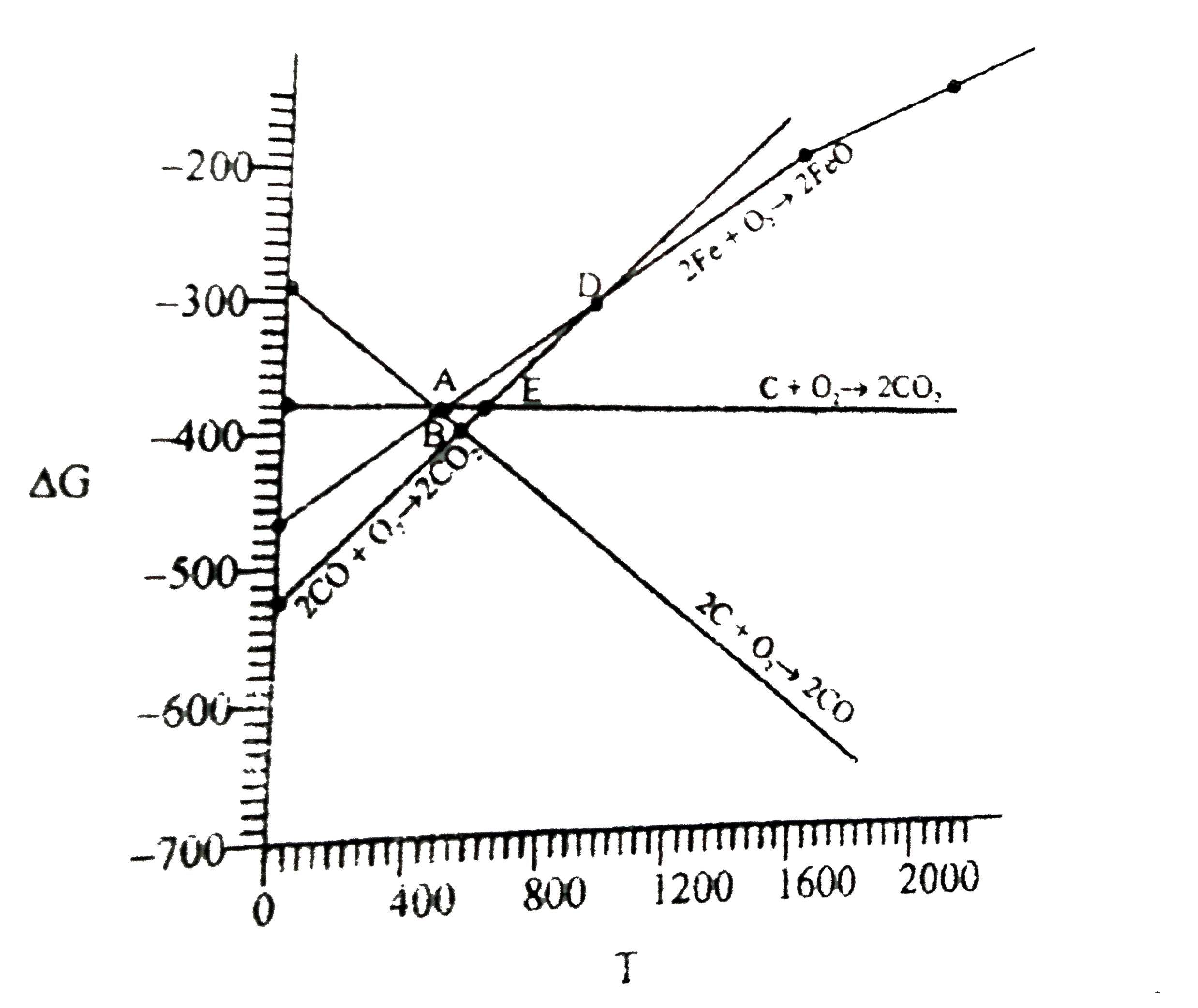Choose the correct option of temperature at which carbon reduced FeO to iron and produces CO

A
Below temperature at point A
B
Approximately at the temperature corresponding to point A
C
Above temperature at point A but below temperature at point D
D
Above temperature at point A
Video Solution
Text Solution
The correct Answer is:D
(d) In the figure shown above point A
ΔrG∘C,CO<ΔfG∘FeFeO
Therefore, above point A , C reduces FeO to Fe forming carbon monoxide Hence, reduction of FeO by carbon occurs above point A only.
|
Updated on:21/07/2023
Related Playlists
Similar Practice Problems
- Question 1 - Select One

Choose the correct option of temperature at which carbon reduces FeO to iron and produces CO.ABelow temperature at point A.BApproximately at the temperature corresponding to point A.CA bove temperature at point A but below temperature at point D.DAbove temperature at point A. - Question 1 - Select One
Choose the correct option of temperature at which carobon reduces FeO to iron and produces CO.
ABelow temperature at point ABApproximately at the temperature correcponding to point ACAboce temperature at point A but below tempeature at point D0DAbove temperature at point A - Question 1 - Select One
Choose the correct options
ABy gamma radiations atomic number is not changedBBy gamma radiations mass number is not changedCBy the emission of one α and two β particles isotopes are producedDBy the emission of one α and four β particles isobars are produced - Question 1 - Select One
Choose the correct options
ACell division helps group of cells to undergo certain modification to form specialised organs.BCell differentiation helps in increasing the number of cells.CIn viviparous animals, development of zygote takes place inside the body.DAll of the above. - Question 1 - Select One or More
Choose the correct options:
AFavourable conditions for formation of graphite are high pressure and low temperature from equilibrium diamond (d=3.5g/ml)⇔ graphite (d=2.3g/ml),Δ=−1.9kJ/moleBFor reaction N2O4(g)⇔2NO,(g), degree of dissociation (α) is √K4P+KP where P is equilibrium pressure.CFor reaction CI2(g)+3F2(g)⇔2CIF3(g),ΔH=−329kJ ,dissociation of CIF3(g) will be favoured by additon of inert gas at constant pressure.DReaction stops at equilibrium (microscopically). - Question 1 - Select One
Choose the correct options :
AIn N2H4, the N-N bond length is greater than expected valueBIn trisilyl amine (SiH3)3 N, the Si-N bond length is lesser than expected valueCThe bond angle in OF2 is lesser than OCl2DThe Be atom in BeCl2(s) in sp3 hybridised - Question 1 - Select One
Choose the correct options .
AAtomic mass unit (u) is 1/12 of the mass of a neutral carbon atom .6C12 in its lowest enegry state 1aμ=931MeVBZ: Atomic number (number of protons)
N: Number of neutrons
A: mass number (A=Z+N)CIsotopes: nuclei having same number of protons but differenct number of neutrons
Isobars: nuclei with same number of A
Isotones: nuclei with same number of neutrons but different are correctDAll options are correct - Question 1 - Select One
Choose the correct options.
ACell division helps group of cells to undergo certain modification to form specialised organs.BCell differentiation helps in increasing the number of cells.CIn viviparous animals, development of zygote takes place inside the body.DAll of the above. - Question 1 - Select One or More
Choose the correct options :
AFirst Ionisation Energy of N> First Ionisation Energy of O- atomBFirst Ionisation Energy of N⊕< First Ionsiation Energy of O⊕ atomCFirst Ionisation Energy of N< First Ionisation Energy of N⊕ atomDFirst Ionisation Energy of O⊕< Second Ionisation Energy of O- atom

